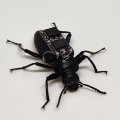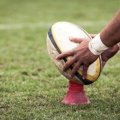A university scholarship has rewarded a student’s passion for the ancient art of slit-drum making and has reinvigorated the industry in Papua New Guinea.
Known as a garamut, the skill and art of making these traditional Papua New Guinean slit-drums has been the focus of PhD student, Alphonse Aime, from The University of Queensland.
Aime was the recipient of The Peter Goodenough and Wantoks PhD Scholarship in Anthropology established in memory of Mr Peter Goodenough, who had extensive business interests and friends in Papua New Guinea.
Goodenough sadly contracted motor neuron disease (MND) and left a major bequest to the Queensland Brain Institute (QBI) to further invest in research to treat this neurological disorder.
To celebrate the success of Aime’s project and the advances in MND research at QBI, a ‘beating of the drums’ ceremony will be held on 3 June, beginning at UQ’s Michie Building Lawns and attended by Dr Diana Young, Director, UQ Anthropology Museum and Professor Perry Bartlett, Director, QBI.
Beating MND – Garamut Ceremony
Monday 3 June 2013 – 12.45pm to 2.00pm
Michie Building Lawns, Chancellor’s Place to Queensland Brain Institute (QBI) Lawns, St Lucia Campus
One of the garamuts to be featured at the ceremony is carved with a traditional design from the village of Kayan, Madang Provence, recently uncovered on a garamut made by German anthropological student Alexis Poser (2004 – 2008) housed in the Berlin Museum.
Aime hopes his project will encourage Papua New Guinean’s to ‘get serious’ about preserving their rich cultural heritage by passing on the traditional knowledge and skills of making garamuts and other artifacts to young people.
At present, the average age of garamut carvers in Papua New Guinea is 50, with few young people interested in the art.
“I predict that by the year 2020, the knowledge, skill and art of making garamuts will be lost forever if no immediate action is taken now to hold onto it,” he said.
Aime is delighted by the impact his project has had on the industry to date.
“My field of research has triggered a renewed interested among the people to hold onto their fasting disappearing traditional or indigenous cultural knowledge and skills, in this case, in making of garamuts as well as other artifacts in Papua New Guinea,” he said.
“They have expressed gratitude and accepted me to be among them.”
Media: Mikaeli Costello, Queensland Brain Institute Communications Manager, 0401 580 685, Mikaeli.Costello@uq.edu.au
About the garamut
Making of garamuts is a professional skill. It is time consuming and drains a lot of energy. It is a skill that one learns from the master carvers over the years. Traditionally, carvers were well fed at every stage of making the garamuts and also kept well supplied with tobacco leaves, betelnut and green coconuts. It also followed custom protocols: the hewing out of the slit and the first sound required a pig to be sacrificed. The launching also came with feasting and pigs were killed for the occasion. The owner of the garamut would pay the carver with dogs’ teeth, pigs’ tusks and other valuable items. In modern times, money exchanges hands as way of paying the carvers.
Peter Goodenough
The Peter Goodenough and Wantoks PhD Scholarship in Anthropology were established in memory of Mr Peter Goodenough (1936 – 2004). Mr Goodenough had extensive business interests and many friends in Papua New Guinea. He sadly contracted motor neuron disease (MND), and was determined to see more being done to fight this debilitating condition. He left a major bequest to the Queensland Brain Institute (QBI) to further invest in research to treat this neurological disorder.
The Peter Goodenough and Wantoks PhD Scholarship in Anthropology
The UQ Anthropology Museum sought a doctoral candidate; who is a PNG citizen to work on the Museum’s PNG Collection. The successful applicant was tasked to build a project around an aspect of local and national identity in PNG embodied in material and/ or visual culture. Among its 24000 accessioned items, the Museum holds more than 4000 artifacts and art works created by people living in PNG and 1700 photographs taken in PNG by missionaries, colonial officials and other visitors. Much of this material dates from the early and mid twentieth century.
.jpg)

